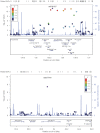Novel loci associated with increased risk of sudden cardiac death in the context of coronary artery disease
- PMID: 23593153
- PMCID: PMC3617189
- DOI: 10.1371/journal.pone.0059905
Novel loci associated with increased risk of sudden cardiac death in the context of coronary artery disease
Abstract
Background: Recent genome-wide association studies (GWAS) have identified novel loci associated with sudden cardiac death (SCD). Despite this progress, identified DNA variants account for a relatively small portion of overall SCD risk, suggesting that additional loci contributing to SCD susceptibility await discovery. The objective of this study was to identify novel DNA variation associated with SCD in the context of coronary artery disease (CAD).
Methods and findings: Using the MetaboChip custom array we conducted a case-control association analysis of 119,117 SNPs in 948 SCD cases (with underlying CAD) from the Oregon Sudden Unexpected Death Study (Oregon-SUDS) and 3,050 controls with CAD from the Wellcome Trust Case-Control Consortium (WTCCC). Two newly identified loci were significantly associated with increased risk of SCD after correction for multiple comparisons at: rs6730157 in the RAB3GAP1 gene on chromosome 2 (P = 4.93×10(-12), OR = 1.60) and rs2077316 in the ZNF365 gene on chromosome 10 (P = 3.64×10(-8), OR = 2.41).
Conclusions: Our findings suggest that RAB3GAP1 and ZNF365 are relevant candidate genes for SCD and will contribute to the mechanistic understanding of SCD susceptibility.
Conflict of interest statement
Figures


References
Publication types
MeSH terms
Substances
Grants and funding
- BHF_/British Heart Foundation/United Kingdom
- UL1 TR000124/TR/NCATS NIH HHS/United States
- P30 DK063491/DK/NIDDK NIH HHS/United States
- 090532/WT_/Wellcome Trust/United Kingdom
- CZB/4/540/CSO_/Chief Scientist Office/United Kingdom
- ETM/137/CSO_/Chief Scientist Office/United Kingdom
- G0800675/MRC_/Medical Research Council/United Kingdom
- R01 HL091069/HL/NHLBI NIH HHS/United States
- G0600329/MRC_/Medical Research Council/United Kingdom
- G0800759/MRC_/Medical Research Council/United Kingdom
- ETM/75/CSO_/Chief Scientist Office/United Kingdom
LinkOut - more resources
Full Text Sources
Other Literature Sources
Medical
Miscellaneous

